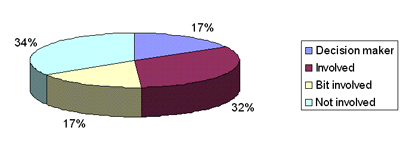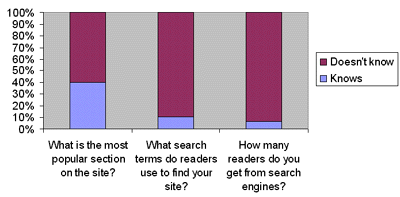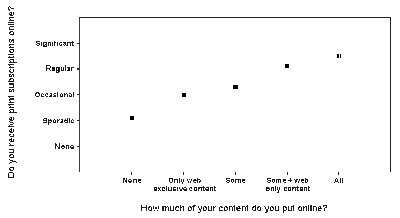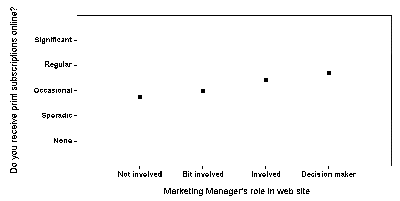|
Most magazines with sites ignore the Internet's marketing power
Analysis of 49 lifestyle magazine marketing professionals' views of the Internet
September 15, 2001
Summary
Magazines are winning online but often do not know it, Pressflex's survey of lifestyle magazine marketing professionals shows.
Nearly four out of five marketing executives at lifestyle magazines with web sites are missing out on their sites' chief benefits - extensive contact with potential subscribers and advertisers and substantial print subscriptions generation, the survey found.
Two out of three lifestyle magazine web sites generate substantial print subscriptions, according to marketing managers for 95 publications in the UK, France and Hungary.
While some publishers have spent 100s of thousands of Euros on showcase sites, online subscription sales has no correlation with development or marketing expenditure, but does relate to the amount of content on the sites and the use of editorial features such as links, forums and e-mail newsletters.
Download this file in .pdf version
Table of Contents
Summary
Databites
Winning subscriptions with the web
Three types of executive
Country comparisons
Cannibalization... or seduction?
What brings sales: big budgets or small steps?
Marketing managers need to get involved
Conclusion
Methodology
Databites
- 96% of lifestyle magazines with web sites receive print subscriptions via their web sites.
- Magazines sell up to 30% of total new subscriptions online, or up to 25 new subscriptions per week.
- An average 6% of marketing budgets are spent online (median = 4%), ranging from nothing to 80%.
- Only 46% of web sites have any involvement from magazine marketing managers.
- There is a high correlation between a marketing manager's engagement in the website and the level of print subscription sales generated.
- Just 17% percent of marketing managers are aware of the "free" market research available from the site - most popular articles, search engine terms used, search engine visits or size of traffic.
Winning subscriptions with the web
More than two thirds of marketing managers at 95 lifestyle magazines in the UK, France and Hungary said they sell a number of subscriptions and back issues through the web, but the majority of the respondents also reported that they have little or no role in shaping their web sites.
Chart 1: Do you receive print subscriptions via the web?

The survey, conducted by phone in August among 49 lifestyle magazine marketing managers, representing 95 magazines, also found that marketing managers receive little feedback from their web teams on what online readers actually care about on their site.
Three types of executive
The marketing managers at the magazines surveyed can be classified into three broad categories: "wired", "waking up" and "indifferent".
Wired (11%). These marketers pay close attention to the web site, are aware of traffic data and/or search terms used to access the site. They have also typically played a significant role in the creation of the web site. Not surprisingly, these magazines win the highest number of print subscriptions online.
Waking up (19%). These are marketing managers who are just coming to realize the importance of the web as a marketing tool. They are typically aware of some traffic data and use information from the web site as part of their market research. They are also trying to carve out some responsibility for themselves in overseeing the site.
Indifferent (70%). This group knows little about the web - or the advantages it offers. They have no information about the traffic of their magazine's web sites, and have had very little - if any - role in the creation of the site.
Chart 2: What has been your role in the creation/management of the web site?

Reflecting the lack of responsibility for the site of the typical marketing manager, at 81% of the magazines the marketing information collected as a by-product of the web sites goes completely unused. "I'm loath to receive data that I cannot use," said the marketing manager at a major UK men's lifestyle magazine. The marketing manager, who also said that his magazine has received subscriptions via the web, has not been involved with the creation and management of the web site.
Chart 3: Use of the web site to gather marketing information

Marketing tactics at the magazines surveyed include a mix of newsstand advertising, television, radio and billboard ads and cross promotion. But the abundance of contacts brought by the web is still overlooked, even at magazines that buy lists for direct mail purposes. In fact, not a single magazine marketing manager interviewed has mentioned the magazine's web site among the magazine's top market research tools, though 26% said that the information gathered from the site does pay some role in the market research efforts of the magazine.
Country comparisons
In the UK, which has the highest Internet penetration among markets surveyed, magazine marketers are more out of the development process than their peers in the less mature market of France and low-penetration Hungary. Just 13% of British marketing managers said they were heavily involved with the web site, with another 19% claiming a "bit" of involvement.
Though those who reported involvement have also said that they use the web site as part of their market research, three quarters did not know what the most popular sections of their magazine were online. None knew what search terms people used to get to their sites.
In France, three quarters of marketing managers were involved in the creation and/or management of their web sites, but even of these managers, two thirds did not know what search words readers used to access their sites. Only half of them knew what the most popular section was on their magazine site.
In Hungary, where 59% of managers in charge of marketing said they have been involved in the creation and management of the web sites, they were even less engaged with the sites: 86% said they had no idea what people are coming to look for, with the majority of respondents not even knowing whether their sites have been registered with and indexed by search engines. Almost two thirds (64%) of respondents did not know what were the most popular sections of their web sites.
Cannibalization... or seduction?
Contrary to the worry that online content cannibalizes print sales the survey indicated that more content online increases print subscriptions.
"At first we were surprised by the number of subscriptions we get online, but now we are used to getting half a dozen each week," said the marketing manager of a small Hungarian magazine, which has decided to put most of its content online. "This is our only marketing expense."
The survey found a direct correlation between the amount of information online and the number of print subscriptions generated through the web site.
Five types of strategies of content management emerged through the research:
- One quarter of the magazines surveyed have no real, updated content on the site, only a description of the magazine, some contact information and a subscription form.
- One third of respondents reported that their sites include headlines from the current issue of the magazine, as well as article teasers in some cases.
- A few magazines include only web exclusive content on the site.
- A few magazines combine headlines and article teasers from the print edition with web exclusive content.
- A few magazines put their entire print content online.
The research found that only sites with some form of real content (categories iii-v) excel in selling print subscriptions via the web.
However, whether that content comes directly from the print edition of the magazine or is online-only content was irrelevant in terms of the number of print subscriptions received. Since putting print content online carries little to no extra costs and has just as positive of a marketing effect as online-only content, it is the most economical way to using the site as a marketing tool.
Chart 4: Content vs. Print Subscriptions sold

Table 1: Content vs. Print Subscriptions sold
| Content online |
All |
Some + Web only content |
Some |
Only web exclusive content |
None |
| Print Subscriptions |
| Significant |
1 |
5 |
3 |
|
|
| Regular |
1 |
3 |
13 |
|
|
| Occasional |
|
|
5 |
1 |
1 |
| Sporadic |
|
2 |
5 |
|
7 |
| None |
|
|
2 |
|
|
What brings sales: big budgets or small steps?
Winning subscriptions online does not correlate with substantial spending. However, a number of small, inexpensive strategies can have a significant impact on winning new readers.
Many of the magazines surveyed have special web teams who have created and are running the site. While in the UK every magazine contacted developed its web site in house, 53% of magazines in France and 64% in Hungary have outsourced development to third parties. None of the magazines surveyed used off-the-shelf products for the creation of their web sites, and only 4% have used an application service provider to create, host and maintain their web sites.
The means and the costs of site development have been irrelevant in the success of the site in generating subscriptions. None of the four French magazines who reported both professionally developed web sites and the use of web exclusive content noted significant subscriptions via the web. Indeed, two of them said they only get sporadic subscriptions.
The magazines where print subscriptions via the site had an important share of overall new subscriptions all have, beyond real content, a significant collection of links to other sites, and - in many cases - e-mail newsletters and reader forums. The correlation was especially significant in France and Hungary, where the less developed Internet market and less content competition in the native language mean that e-mail newsletters sent out by magazine publishers have fewer other marketing e-mails with which to compete.
Marketing managers need to get involved
Even at the largest magazines in the countries surveyed, full-time web teams consist of chiefly technical and editorial staff with no dedicated marketing involvement.
When the marketing manager of the print product does get involved with the web site, the expertise the marketing manager lent to the online operation paid off in new print subscriptions.
Chart 5: Marketing manager's role vs. Subscriptions

Table 2: Marketing manager's role vs. Subscriptions
| |
Decision maker |
Involved |
Bit involved |
Not involved |
| Significant |
2 |
4 |
1 |
2 |
| Regular |
6 |
8 |
2 |
1 |
| Occasional |
|
|
3 |
2 |
| Sporadic |
1 |
1 |
2 |
10 |
| None |
1 |
1 |
1 |
|
Many marketers with big plans and deep pockets admit that they mostly guess when it comes to promoting themselves using the Internet or backing up their e-marketing plans with data.
A large UK interior decorations magazine with a bespoke web site, for instance, plans to spend 80% of its marketing budget online, and is hoping to generate 15% of its new subscribers via the web as a result. The site has little print content and few links, and the marketing manager does not know what search terms people use to find the publication.
On the other hand, a small Hungarian lifestyle magazine with full print content and monthly e-mail updates generates 30% of its new subscribers via the web - with no funding allocated to marketing online. A French outdoor sports magazine also spends no money on e-marketing, but has a 100-strong link collection, full print content and four separate e-mail newsletters to people can subscribe - generating 10 new print subscriptions per week.
Conclusion
Although many magazine marketing professionals pay no attention to the opportunities offered by the Internet, content-rich web sites can provide substantial a marketing boost. Marketing executives who ignore the Internet leave money on the table, passing up free research and cheap subscriptions.
Methodology
For inclusion in the survey, lifestyle magazines were picked from media directories for the UK, France and Hungary. Interviews with marketing managers at magazines with web sites were conducted by telephone by Pressflex staff in the native language of the marketing managers. Of the 67 marketing managers contacted, 49, representing 95 magazines, participated in the survey.
Return to Top
File:
Pressflex Magazine Web Report (.pdf)
(63k)
|

